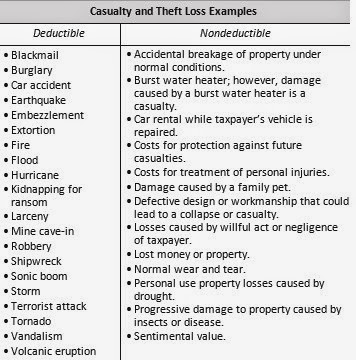Ordinary and necessary job expenses which were not
reimbursed are deductible. Ordinary and
necessary expenses reimbursed by the
employer and reported as income in box 1, Form W-2, are also deductible. An
ordinary expense is one that is common and accepted in the taxpayer’s line of
work. A necessary expense is one that is helpful and appropriate for work. An
expense does not have to be required to be considered necessary.Tax Reporting
A taxpayer must report on his or her tax return if any of
the following apply.
• The
employee claims any job-related vehicle, travel, transportation, meal, or
entertainment expenses.
• The
employer reimbursed any reportable expenses.
• The
employee claims any job related expenses as a reservist, a qualified
performing artist, a fee-basis state or local government official, or an
individual with a disability claiming impairment-related work expenses.
Standard Mileage Rate
The business standard mileage rate for 2013 is 56.5¢ per
mile.
Examples of other job expenses deductible as unreimbursed employee expenses:
• Business
bad debt.
• Business
liability insurance premiums.
• Casualty
and theft losses of property used in performing services as an employee.
• Depreciation
on a computer or cell phone required by an employer.
• Dues to professional organizations and chambers of commerce if work related and
entertainment is not one of the main purposes of the organization. Any part of
dues that is for lobbying and political activities is nondeductible.
• Education
expenses related to work.
• Job
search fees to employment agencies and other costs to look for a new job in the
taxpayer’s present occupation, even if the taxpayer does not find a new job.
• Legal
fees related to work.
• Licenses
and regulatory fees.
• Lobbying
expenses to influence local legislation, and other exceptions to the general
rule.
• Malpractice
insurance premiums.
• Occupational
taxes.
• Office-in-home
expenses as an employee.
• Phone
charges for business use, but not the cost of basic service for the first phone
line into a residence.
• Physical
examinations required by employer.
• Protective
clothing required for work, such as hard hats, safety shoes, and glasses.
• Safety
equipment needed for work.
• Subscriptions
to professional journals and trade magazines related to work.
• Tools
and supplies used for work.
• Uniforms
required by employer that are not suitable for ordinary wear.
• Union
dues and expenses.
Job Search Expenses
Expenses incurred in looking for a new job in the taxpayer’s
present occupation are deductible, even if the taxpayer does not get a new job.
Job search expenses are not deductible for:
• Looking
for a job in a new occupation.
• A
substantial break between the ending of the last job and looking for a new job.
• The
taxpayer looking for a job for the first time.
Uniforms and Work Clothes
The cost and upkeep of uniforms and work clothes are
deductible if:
• The
taxpayer must wear them as a condition of employment, and
• The
clothes are not suitable for everyday wear.
• It
is not enough that the taxpayer wears unique or distinctive clothing on the
job, or that the taxpayer does not in fact wear the work clothing away from
work.
Lobbying Expenses
Expenses to influence legislation are not deductible.
Exceptions:
• Expenses
for attempting to influence the legislation of any local council or similar
local government, including an Indian tribal government.
•
Up to $2,000 per year (not counting overhead expenses)
for in-house expenses to influence legislation or communicating directly with a covered
executive branch official.
• Expenses of a professional lobbyist in the trade or business of lobbying on
behalf of another person.
Residential Telephone Line
The cost of local telephone service for the first telephone
line into a taxpayer’s residence is not deductible, even if it is used in a
trade or business. Any added charges for business use are deductible, such as
the cost of a second line, fax line, long distance, voice mail, internet
service, etc.
Unclaimed Reimbursements
If a taxpayer is entitled to be reimbursed by his or her
employer for job-related costs but does not put in a claim for reimbursement,
the costs are not deductible.
Travel Expenses
Travel expenses are ordinary and necessary expenses
incurred by a taxpayer while on temporary travel away from his or her tax home
for business purposes. A taxpayer travels away from his or her tax home if the
taxpayer’s business duties require an absence from home that is substantially
longer than a day’s work, and the taxpayer needs sleep or rest to meet the
demands of the work while away from home. The tax home includes the entire city
or general area in which the taxpayer’s business is located.
Standard meal
allowance. A taxpayer can substantiate meal and incidental expenses with a
standard meal allowance ($46 per day from October 1, 2012 through September 30,
2013). Additional amounts may apply for certain high-cost localities, based on
IRS Publication 1542, Per Diem Rates.
Lodging. Although an employer can
reimburse an employee tax free for qualified lodging at per diem rates, for an
employee or self-employed individual, only actual expenses are allowed for
lodging.










